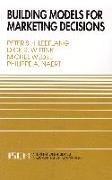- Start
- Building Models for Marketing Decisions
Building Models for Marketing Decisions
Angebote / Angebote:
The market environment is changing rapidly. Prior to scanner data, ACNielsen, the major supplier of information on brand performances, said its business was to provide the score but not to explain or predict it. Now, model-based insights are not only demanded by managers, but can also be meaningfully provided. It is common for managers in many countries to receive market feedback frequently, quickly and in great detail due to the use of scanners and computers. With advances in information technology and expertise in modeling, IRI introduced model-based services in the US that explain and predict essential parts of the marketplace. ACNielsen followed, and marketing researchers have been developing increasingly valid, useful and relevant models of marketplace behavior ever since. Models that provide information about the sensitivity of market behavior to marketing activities such as advertising, pricing, promotions and distribution are now routinely used by managers for the identification of changes in marketing programs that can improve brand performances. Building Models for Marketing Decisions describes marketing models that managers can use as an aid in decision making. It has long been known that even simple models outperform judgments in predicting outcomes in a wide variety of contexts. More complex models potentially provide insights about structural relations not available from casual observations. Although marketing models are now widely accepted, the quality of the marketing decisions is critically dependent upon the quality of the models on which those decisions are based. In this book, which is a revision and expansion of Naert and Leeflang's Building Implementable Marketing Models (1978), the authors discuss in detail the model-building process. They distinguish four parts in this process: specification, estimation, validation and use of models. Throughout the book, the authors provide examples and illustrations. This book will be of interest to researchers, analysts, managers and students who want to understand, develop or use models of marketing phenomena.
Folgt in ca. 15 Arbeitstagen




